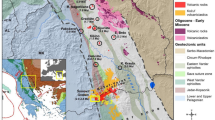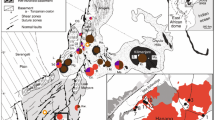Summary
Suites of coarse-grained clasts (“plutonic nodules“) within the scoria of two separate mafic post-caldera parasitic vents, on Sete Cidades volcano, are described. These involve dunites, wehrlites, olivine clinopyroxenites, clinopyroxenites and olivine gabbros in the Eguas ankaramitic cone and pyroxene hornblendites, kaersutite gabbros and diorites in the Pico das Camarinhas basaltic-hawaiitic cone. The plutonic nodules are inferred to be cumulates, crystallised within the crust from magmas co-genetic with the post-caldera mafic lavas erupted on the flanks of Sete Cidades.
The dunites, wehrlites, pyroxenites and olivine gabbros have assemblages and mineral composition consistent with growth as early, high-temperature cumulates, whereas the pyroxene hornblendites, kaersutite gabbros and diorites represent lower temperature products. However, whereas the kaersutite gabbros were not wholly crystallised at the time of their disruption and contain up to 4% intercumulus trachytic and/or tephriphonolitic glass, the pyroxene hornblendites and the diorites were fully crystallised. Compositions of the intercumulus glasses are similar to those of postcaldera trachytic pumices erupted on Sete Cidades.
Although the two suites of plutonic clasts can be considered as complementary, they probably derive from different intrusions. We envisage a lensoid (laccolithic) intrusion at very shallow depth as the source for the pyroxene hornblendite - kaersutite gabbro -diorite suite whereas the dunite - wehrlite - olivine clinopyroxenite - clinopyroxenite -olivine gabbro nodules probably originate from intrusive bodies at greater depth.
Zusammenfassung
Wir beschreiben Gruppen von grobkörnigen Klasten (‘Plutonic nodules’) in der Scoria von zwei separaten mafischen post-caldera parasitischen Kratern am Sete Cidades Vulkan: Diese umfassen Dunite, Wehrlite, Olivin-Klinopyroxenite und Olivin-Gabbros in dem ankaramitischen Kegel von Eguas. In den basaltisch-hawaiitischen Kegeln von Pico das Camarinhas, kommen Pyroxen-Hornblendite, Kaersutit-Gabbros und Diorite vor. Wir nehmen an, daß die plutonischen nodules Kumulate repräsentieren, die in der Kruste aus Magmen kristallisierten, die mit den post-caldera mafischen Laven, die an den Flanken von Sete Cidades ausgetreten sind kogenetisch sind.
Die Dunite, Wehrlite, Pyroxenite und Olivin-Gabbros führen Paragenesen und Mineral-Zusammensetzungen, die im Einklang mit einer Entwicklung als frühe Hoch Temperatur-Kumulate sind. Hingegen stellen die Pyroxen-Hornblendite, Kaersutit-Gabbros und Diorite niedriger temperierte Produkte dar. Die Kaersutit-Gabbros waren zur Zeit /:ihrer Umlagerung noch nicht ganz auskristallisiert und führen bis zu 4% intercumulus trachytisches oder tephriphonolitisches Glas, die Pyroxenhornblendite und die Diorite sind jedoch ganz kristallisiert. Die Zusammensetzungen der Interkumulusgläser sind denen von post-caldera trachytischen Bimssteinen von Sete Cidades ähnlich.
Obwohl die zwei Gruppen plutonischer Klasten als komplementär betrachtet werden können, stammen sie wahrscheinlich von verschiedenen Intrusionen. Es dürfte sich um eine lensoide (lakkolithische) Intrusion in geringer Tiefe als Quelle für die Pyroxenhomblendit-Kärsutitgabbro-Diorit-Abfolge handeln, während die Gruppe der Dunite, Wehrlite, Olivinklinopyroxenite und Olivingabbro-Nodules wahrscheinlich aus größerer Tiefe stammt.
Similar content being viewed by others
References
Anastasiou P, Seifert F (1972) Solid solubility of Al2O3 in enstatite at high temperatures and 1-5 Kb water pressure. Contrib Mineral Petrol 34: 272–287
Anderson AT (1980) Significance of hornblende in calk-alkaline andesites and basalts. Am Mineral 65: 837–851
Aoki K (1963) The kaersutite and oxykaersutite from alkalic rocks of Japan and surrounding areas. J Petrol 4: 198–210
Bennel MJ (1969) Ultrabasic and basic nodules from the Azores. Proc Geol Soc London 1658: 252–253
Best MG, Mercy ELP (1967) Composition and crystallization of mafic minerals in the Guadalupe igneous complex, California. Am Mineral 52: 436–475
Booth B, Croasdale R, Walker GPL (1978) A quantitative study of five thousand years of volcanism on Sâo Miguel, Azores. Phil Trans R Soc London 288: 271–319
Cann JR (1967) A second occurrence of dalyite and the petrology of some ejected syenite blocks from Sao Miguel, Azores. Mineral Mag 33: 227–232
Davis AS, Clague DA (1990) Gabbroic xenoliths from the northern Gorda ridge: implications for magma chamber processes under slow spreading centers. J Geophys Res 95: 10885–10905
de Silva SL (1991) Styles of zoning in Central Andean ignimbrites - insights into magma chamber processes. Geol Soc Am Spec Pap 265: 217–231
de Silva SL, Wolff JA (1995) Zoned magma chambers: the influence of magma chamber geometry on sidewall convective fractionation. J Volcanol Geotherm Res 65: 111–118
Dixon JE, Clague DA, Eissen JP (1986) Gabbroic xenoliths and host ferrobasalt from the southern Juan de Fuca ridge. J Geophys Res 91: 3795–3820
Fan Q, Hooper PR (1989) The mineral chemistry of ultramafic xenoliths of eastern China: implications for upper mantle composition and the paleogeotherms. J Petrol 30: 1117–1158
Hermes OD, Cornell WC (1981) Quenched crystal mush and associated magma compositions as indicated by intercumulus glasses from Mt. Vesuvius, Italy. J Volcanol Geotherm Res 9: 133–149
Irvine TN (1982) Terminology for layered intrusions. J Petrol 23: 127–162
Krause DC, Watkins ND (1970) North Atlantic crustal genesis in the vicinity of the Azores. Geophys J R Astron Soc 19: 261–283
Kushiro I (1960) Si-Al relation in clinopyroxenes from igneous rocks. Am J Sci 258: 548–554
Leake BE (1978) Nomenclature of amphiboles. Am Mineral 63: 1023–1052
Le Bas MJ, Le Maitre RW, Streckeisen A, Zanettin R (1986) A chemical classification of volcanic rocks based on the total alkali-silica diagram. J Petrol 27: 745–750
Le Maitre RW (1989) A classification of igneous rocks and glossary of terms. Blackwell, Oxford, 193pp
Leterrier J, Mauty RC, Thonon P, Girard D, Marchal M (1982) Clinopyroxene composition as a method of identification of the magmatic affinities of paleo-volcanic series. Earth Planet Sci Lett 59: 139–154
Meyer PS, Dick HJ, Thompson G (1989) Cumulate gabbros from the Southwest Indian Ridge 54°S-7°16Έ: implications for magmatic processes at a slow spreading ridge. Contrib Mineral Petrol 103: 44–63
Moore RB (1990) Volcanic geology and eruption frequency, São Miguel, Azores. Bull Volcanol 52: 602–614
Moore RB (1991) Geology of three late Quaternary stratovolcanoes on São Miguel, Azores. US Geol Survey Bull 1900: 46 pp
Moore RB, Rubin M (1991) Radiocarbon dates for lava flows and pyroclastic deposits on São Miguel, Azores. Radiocarbon 33: 151–164
Papike JJ, Cameron KL, Boldwin K (1974) Amphiboles and pyroxenes: characterization of other than quadrilateral components and estimates of ferric iron from microprobe data. Geol Soc Am Progr Abstr 6: 1053–1054
Pemberton JW, Offler R (1985) Significance of clinopyroxene compositions from Cudgegong volcanic area, Toolamanang volcanics, Cudgegong-Mudgee district, NSW, Australia. Mineral Mag 49: 591–599
Schmincke HU (1973) Magmatic evolution and tectonic regime in the Canary, Madeira and Azores island groups. Geol Soc Am Bull 84: 633–648
Searle R (1980) Tectonic pattern of the Azores spreading centre and triple junction. Earth Planet Sci Lett 51: 415–434
Self S, Gunn BM (1976) Petrology, volume and age relations of alkaline and saturated peralkaline volcanics from Terceira, Azores. Contrib Mineral Petrol 54: 293–313
Sen G (1987) Xenoliths associated with the Hawaiian Hot Spot. In:Nixon PH (ed) Mantle xenoliths. Wiley, Chichester, pp 359–375
Sweatman TR, Long JVP (1969) Quantitative electron microanalysis of rock-forming minerals. J Petrol 10: 332–379
Spencer KJ, Lindsley DH (1981) A solution model for coexisting iron-titanium oxides. Am Mineral 66: 1189–1201
Thompson RN (1974) Some high-pressure pyroxenes. Mineral Mag 39: 768–787
Velde B, Kushiro I (1978) Structure of sodium-alumino silicate melts quenched at high pressure; infrared and aluminum K-radiation data. Earth Planet Sci Lett 40: 137–140
Verhoogen J (1962) Distribution of titanium between silicates and oxides in igneous rocks. Am J Sci 260: 211–220
Vieten K (1980) The minerals of the volcanic rock association of the Siebenbirge. 1. Clinopyroxenes. 2. Variation of chemical composition of Ca-rich clinopyroxenes (salites) in the course of the crystallization. N Jb Mineral Abh 140: 54–88
Watson EB (1976) Glass inclusions as samples of early magmatic liquid: determinative method and application to a South Atlantic basalt. J Volcanol Geotherm Res 1: 73–84
White RW (1966) Ultramafic inclusions in basaltic rocks from Hawaii. Contrib Mineral Petrol 12: 254–314
White WM, Tapia MDM, Schilling JG (1979) The petrology and geochemistry of the Azores islands. Contrib Mineral Petrol 69: 201–213
Widom E, Gill JB, Schmincke HU (1993) Syenite nodules as a long-term record of magmatic activity in Agua de Pao volcano, São Miguel, Azores. J Petrol 34: 929–953
Wolff JA (1987) Crystallisation of nepheline syenite in a subvolcanic magma system: Tenerife, Canary Islands. Lithos 20: 207–223
Wolff JA, Toney JB (1993) Trapped liquid from a nepheline syenite: a re-evaluation of Na-, Zr-, F-rich interstitial glass in a xenolith from Tenerife, Canary Islands. Lithos 29: 285–293
Author information
Authors and Affiliations
Additional information
With 9 Figures
Rights and permissions
About this article
Cite this article
Mattiolil, M., Upton, B.G.J. & Renzulli, A. Sub-volcanic crystallization at Sete Cidades volcano, São Miguel, Azores, inferred from mafic and ultramafic plutonic nodules. Mineralogy and Petrology 60, 1–26 (1997). https://doi.org/10.1007/BF01163132
Received:
Accepted:
Issue Date:
DOI: https://doi.org/10.1007/BF01163132




